Travel: Find ‘peace, love and sandy feet’ in the Florida Keys
- Oops!Something went wrong.Please try again later.
BAHIA HONDA KEY, Fla. — We yearned for “peace, love and sandy feet” in warm climes. So, we snagged a cabin rental and bolted to the Florida Keys. Our goals were simple: stroll the beaches, read books, eat fresh seafood and enjoy brilliant sunsets.
The string of about 44 islands dangling south from the Florida Peninsula is a world all its own. Centuries of isolation ended in the early 1910s when Henry Flagler’s Florida East Coast Railway extended more than 100 miles down to Key West.
Then, in 1938, the Overseas Highway was completed, opening the Keys to automobile traffic. The engineering feat continues to marvel with its 42 bridges. The road serves loosely as a dividing line between the sparkling Atlantic Ocean on one side and the emerald Gulf of Mexico on the other.
The highway ties together small communities with links to the commercial fishing, recreational boating and deep-sea diving. The locals have held onto an easy-going, laid-back vibe that attracted artists and entrepreneurs, making the Florida Keys a haven for free spirits.
The Everglades: Gateway to the Keys
Any road trip to the Florida Keys begs for a slight detour on the mainland to visit the vast swamps of the Everglades. In Everglades National Park, we followed the boardwalk from the Royal Palm Visitor Center and soon spotted alligators, anhingas, cormorants and white herons.
Upon reaching Flamingo on Florida Bay, we boarded a tour boat for a 90-minute ride up the Buttonwood Canal through Coot Bay and Tarpon Creek into Whitewater Bay. Naturalist guide Mitchell Ballis was quick to spot crocodiles resting on the sandy banks. Southern Florida is the only place where American crocodiles and alligators share habitats. Ballis highlighted three types of mangroves, and shared a joke about the rust-coated gumbo-limbo. “It’s nicknamed ‘the tourist tree’ because its peeling bark resembles the skin of a sunburnt tourist,” he said. Kayakers admired a pair of curious manatees that followed them in the canal.
Playing the Keys
We made our way to Key Largo, and officially began the 113-mile journey to Key West. Key Largo is loved by divers and snorkelers largely because of John Pennekamp Coral Reef State Park with its vibrantly colored corals and tropical fish. This state park, one of 10 state parks in the Florida Keys, showcases lush mangrove forests and sandy beaches. The Keys also boast four National Wildlife Refuges.

Big game fishing is huge at Islamorada 16 miles farther down the Keys. President George H.W. Bush hosted a bonefish tournament there for nearly 10 years. The Florida Keys History and Discovery Center highlights this sports-fishing tradition and other aspects of the islands, including pirates of the past and treasure hunting by shipwreck-salvaging crews. Comprehensive displays also focus on the contributions of the native people of the Calusa and Tequesta tribes.
We learned of marine mammal behavior at the nonprofit Dolphin Research Center on Grassy Key. The facility cares for nearly 30 bottlenose dolphins, kept in deep lagoons in the Gulf of Mexico. Visitors can watch feeding routines and health checks. For an extra fee, they can swim with the dolphins.
Marathon in the Middle Keys
The commercial fishing fleet shares marina space with pleasure sailboats in Marathon, a city of nearly 10,000 people.
Seafood shacks and tiki bars flavor the dining scene. Locals and tourists gather at the casual eateries of Marathon as well as nearby Sombrero Beach, which has an oceanside park with soft white sand, lush palm trees, picnic pavilions and volleyball courts. The beach is protected during turtle nesting season.
At the Crane Point Museum, Hammock and Nature Center, we walked through a 64-acre, tropical hardwood forest and wild mangrove wetlands to visit several historic structures. The George Adderley House, completed in 1906, is the only surviving tabby house in the Keys. It belonged to a Bahamian immigrant who harvested sponges and made charcoal.

After crossing the Seven Mile Bridge, the islands are less developed for a long stretch. We landed at Bahia Honda State Park and shared our stay with white herons, ibises, manatees, dolphins and plenty of friendly folk. The name Bahia Honda means “deep bay” and appears on centuries-old Spanish nautical maps.
Dense tropical vegetation, including silver palm, satinwood, sea lavender and mangroves, blanket the 524-acre state park, which has two large lagoons and three beaches. The biggest decision most visitors face all day is whether to swim in the Gulf of Mexico or walk about three minutes east to do the same in the Atlantic Ocean. On most days it is just a matter of which way the wind blows. Early one morning, we watched a ray with winged fins four feet across glide through the shallows along Calusa Beach. Needle fish and yellow-and-black striped Sergeant Major fish swim near a coral rock formation.
The state park’s most striking feature is the old Bahia Honda Bridge, part of the original railway, which allowed views across a 30-foot-deep channel that presented many challenges to the track builders. A nightly ritual is watching the sun set and jubilantly blowing into conch shells in celebration of day’s end. Nighttime came upon us as we walked to our cabin along the Gulf beach and were treated to an electric display of a hundred jellyfish lighting up in the shallow water. Once their show was over, we looked up to catch the dazzling display of thousands of stars.
Going South
The biggest natural attraction is the Lower Keys is actually quite small.
The tiny Key deer, an endangered subspecies of the white-tailed deer, grows to a height of about three feet. The endearing creature is found only on Big Pine Key and its surrounding islands. The National Key Deer Refuge, which covers much of Big Pine Key and nearby No Name Key, was established in 1957 to protect the animal.
Key West may still be “a haven for those who choose to drop out of conventional society,” as longtime resident playwright Tennessee Williams wrote, but plenty of other folks have joined them.
The city has grown to a population of more than 26,000, but it hasn’t lost its balmy charm. Duval Street, Mallory Square, the historic seaport district and a hundred other wild-and-quirky elements keep Key West the party destination it has always been.

History and literature buffs flock to the Ernest Hemingway Home and Museum, Tennessee Williams Museum, Harry S Truman Little White House and the Key West Lighthouse and Keeper’s Quarters.
Visitors pose for pictures at the red, yellow and black monument denoting the southernmost point in the continental United States. In the harbor area and along Duval Street, restaurants, bars and brewpubs line the walkways. On Duval Street, musicians play Jimmy Buffett songs, and buskers perform for tips at Mallory Square. Life is still good in Key West.
Cruise to Dry Tortugas National Park
Dry Tortugas National Park in the Gulf of Mexico preserves Fort Jefferson and the seven Dry Tortugas islands. These islands are the last in a chain that extends 200 miles northward to Miami, making it the largest coal reef chain in the United States. The Dry Tortugas reefs are the least disturbed reefs of the Florida Keys and they are highly valued by divers and snorkelers.
We boarded the high-speed catamaran, Yankee Freedom, in Key West for a 2.5-hour, 70-mile cruise to Garden Key, site of Fort Jefferson, one of the largest all-masonry fortifications in America. Guided tours of the fort reveal its rich history. The fort was built to protect American trade and shipping lanes in the Gulf of Mexico.
The lighthouse on Garden Key was constructed in 1825, then replaced in 1876 with an iron-plate lighthouse. A taller lighthouse was built in 1856 on nearby Loggerhead Key. The reefs and shoals of the Dry Tortugas have wrecked more than 200 ships since the 1500s.
For many, snorkeling is the big attraction here because of the exceptionally clear water. Multitudes of fish, including Spanish hog fish, blue tang and tiger grouper swim in the sun-dappled water surrounding the coral islet.
Linda Lange and Steve Ahillen are travel writers living in Knoxville, Tenn.
This article originally appeared on Knoxville News Sentinel: Travel: Find ‘peace, love and sandy feet’ in the Florida Keys

